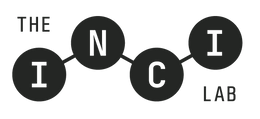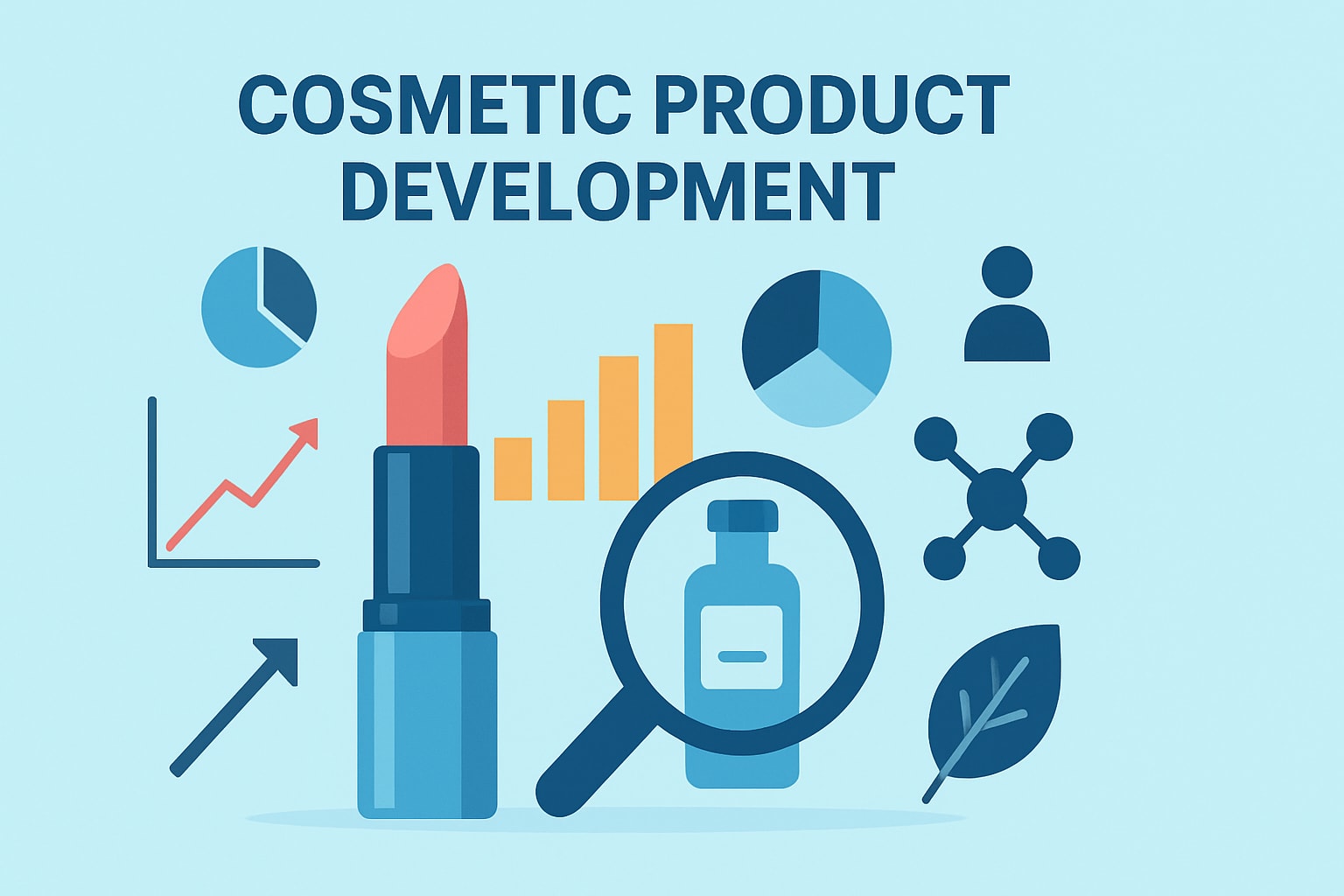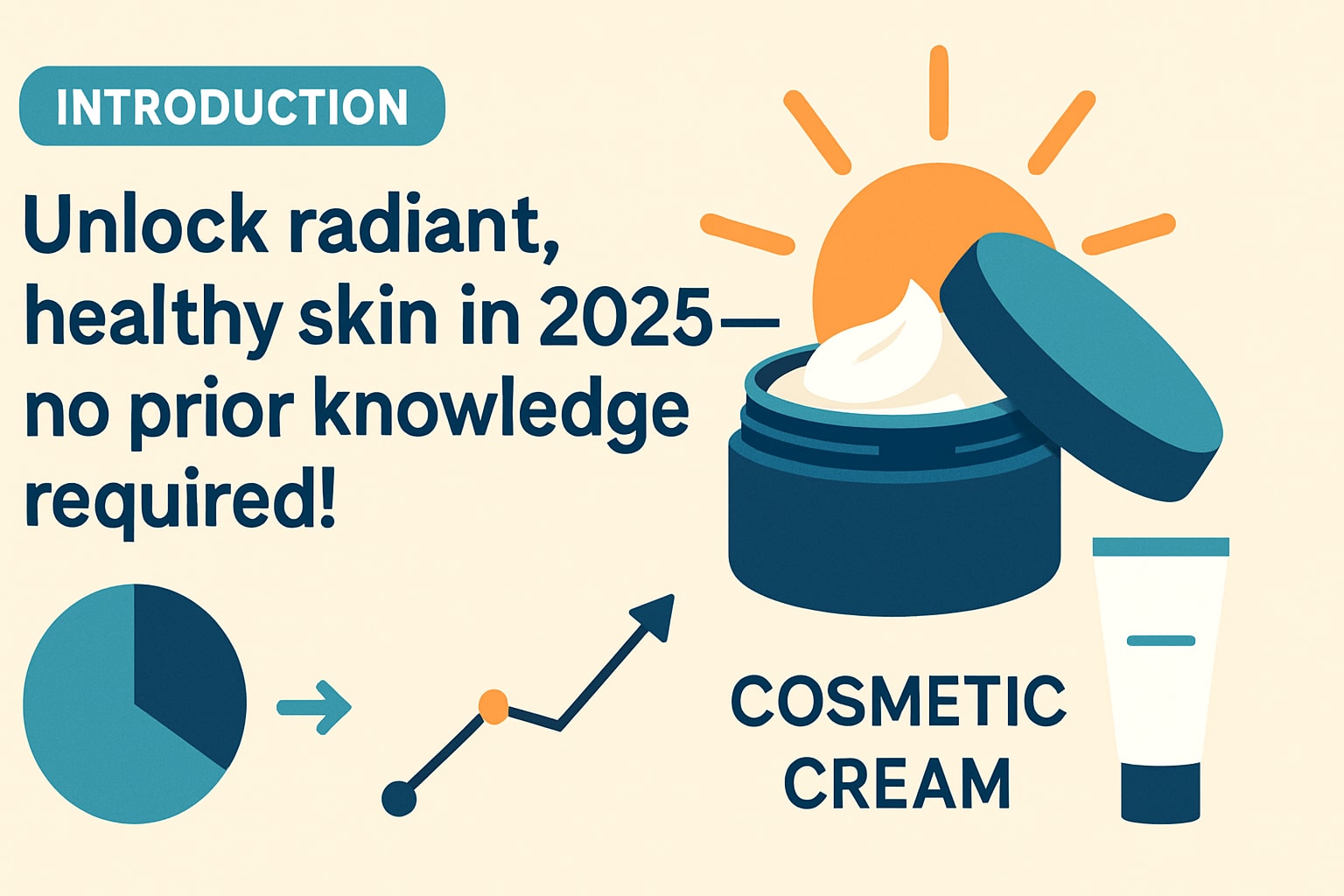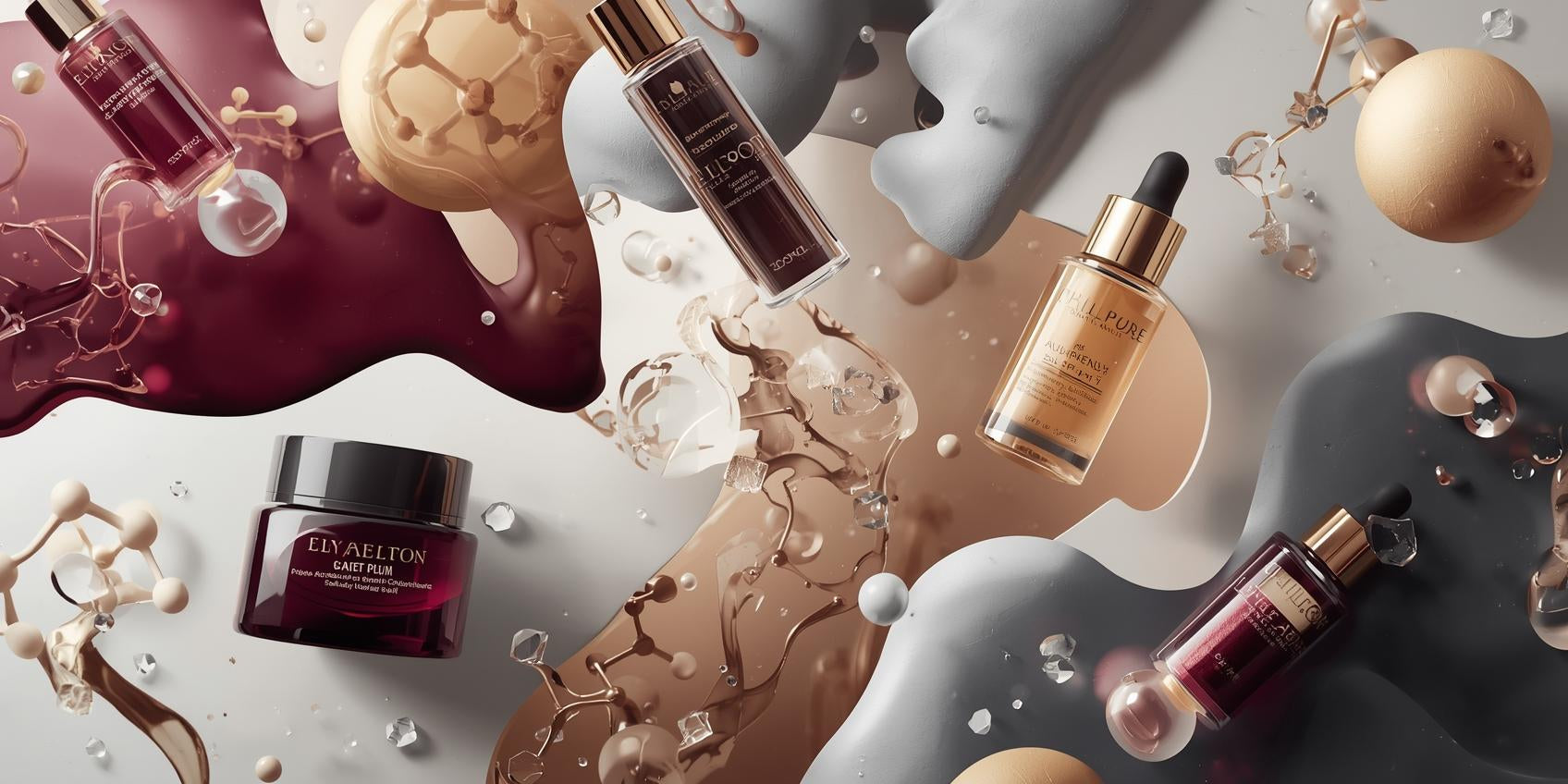The cosmetic formulation landscape is experiencing unprecedented change as we approach 2025. Global demand for innovative, clean, and sustainable beauty products continues to surge, with the industry projected to exceed $800 billion in value. This expert guide to cosmetic formulation will empower you with the latest trends, must-know ingredients, step-by-step formulation strategies, regulatory updates, and innovation insights. Whether you are a brand owner, formulator, or entrepreneur, discover actionable knowledge and practical tools to excel in this dynamic market. Ready to unlock new opportunities and lead in cosmetic formulation? Let’s dive in.
The State of Cosmetic Formulation in 2025
The world of cosmetic formulation is entering a transformative era as we head into 2025. The global cosmetics market is projected to reach unprecedented heights, driven by rapid advancements and shifting consumer values. According to recent Global Cosmetic Ingredients Market Projections, the sector is expected to see robust growth, with revenues climbing steadily and a compound annual growth rate that highlights the industry’s resilience.
Several key drivers are shaping the direction of cosmetic formulation. Consumer demand for clean beauty continues to fuel innovation, with transparency in sourcing and ingredient safety at the forefront. Personalization is rising in importance, as more brands deliver tailored skincare and makeup solutions that address individual needs. Scientific innovation, particularly in ingredient development and delivery systems, is enabling products to perform better while meeting evolving expectations.
Advanced technologies are now central to cosmetic formulation. Artificial intelligence is revolutionizing ingredient selection, predictive stability testing, and even consumer personalization. High-throughput testing methods are streamlining the R&D process, allowing formulators to test multiple variables efficiently. Digital twins, or virtual replicas of products, are being used to simulate real-world performance and accelerate time-to-market for new launches.
Despite these advancements, the industry faces notable challenges. Ingredient sourcing has become more complex due to global supply chain disruptions and increased scrutiny on ethical practices. Regulatory environments are also changing, requiring brands to stay updated on ingredient bans, labeling requirements, and cross-border compliance. Navigating these complexities is essential for any business involved in cosmetic formulation.
Social media and e-commerce platforms are dramatically influencing product development cycles. Brands must respond quickly to viral trends, consumer feedback, and influencer-driven demands, making agility a critical component of success. The digital landscape also allows for direct engagement with consumers, providing valuable insights that guide future formulation strategies.
Inclusivity is another defining characteristic of cosmetic formulation in 2025. Brands are expanding their product ranges to cater to a wider array of skin types, tones, and cultural preferences. This shift reflects a broader recognition of diversity within the global consumer base and the need for products that offer both efficacy and representation.
Industry reports reveal that natural and organic product segments are experiencing significant growth. Consumers are seeking transparency and sustainability, with trust metrics showing a clear preference for brands that prioritize ethical sourcing and environmentally friendly practices. Recent launches from major brands showcase innovative uses of sustainable packaging, as well as the integration of AI-driven formulation to meet both regulatory and consumer expectations.
The state of cosmetic formulation in 2025 is defined by a blend of technological innovation, consumer-centric design, and a commitment to sustainability. Staying ahead requires a deep understanding of market trends, regulatory landscapes, and the evolving needs of a diverse global audience.
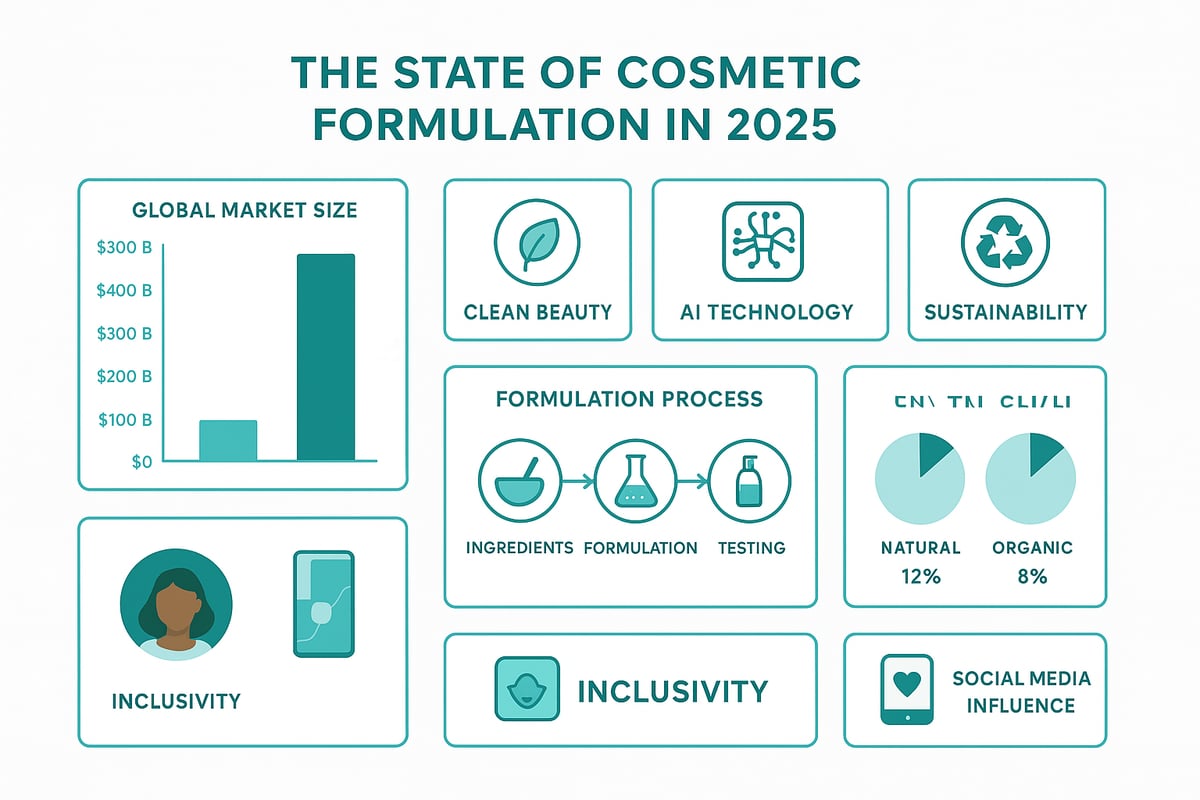
Essential Ingredients and Raw Materials in Modern Formulation
The landscape of cosmetic formulation is rapidly evolving as we approach 2025, with a strong emphasis on innovative and sustainable ingredients. Formulators are rethinking their approaches to meet consumer demands, regulatory standards, and environmental goals. Let’s examine the essential trends, classifications, and sustainability efforts shaping modern cosmetic formulation.
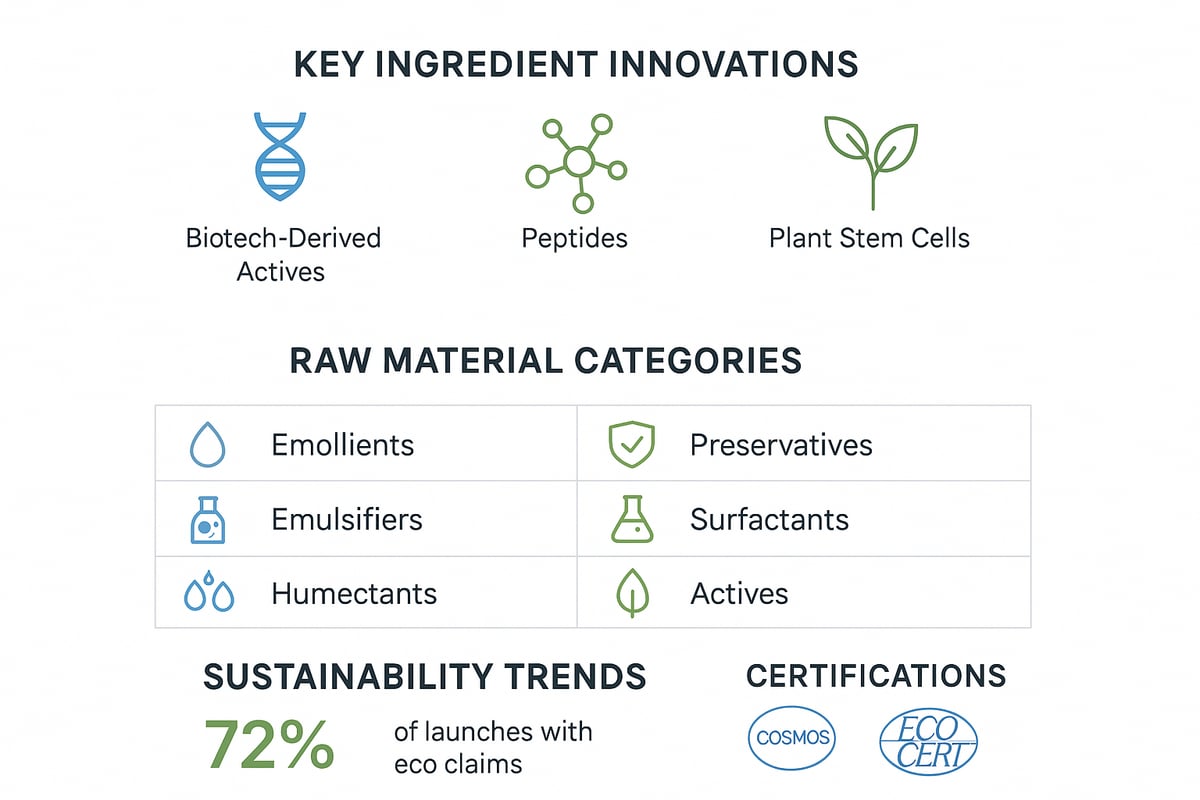
Ingredient Innovation and Trends
In 2025, ingredient innovation is at the forefront of cosmetic formulation. Biotech-derived actives, such as lab-engineered peptides and plant stem cells, are enabling brands to deliver targeted performance while minimizing environmental impact. Multifunctional ingredients are now favored for their ability to improve efficacy and streamline formulations, reducing the overall ingredient load.
Fermented botanicals and upcycled ingredients are gaining traction, offering both sustainability and enhanced bioavailability. Encapsulated vitamins, like stabilized vitamin C, ensure longer shelf life and improved skin delivery. Demand for vegan and cruelty-free ingredients is surging, with recent data showing a double-digit increase in new product launches bearing these claims.
For a deeper dive into ingredient trends shaping the market, see Key Cosmetic Ingredient Trends Set to Reshape the 2025 Market.
Raw Material Classification and Selection
A successful cosmetic formulation depends on the careful selection and combination of raw materials. Ingredients are typically classified as follows:
| Category | Function Example |
|---|---|
| Emollients | Moisturize and soften skin |
| Emulsifiers | Blend oil and water phases |
| Humectants | Attract and retain moisture |
| Preservatives | Prevent microbial growth |
| Surfactants | Cleanse and create foam |
| Actives | Deliver targeted benefits |
Selection criteria include safety, efficacy, sensory profile, and compatibility with other ingredients. For instance, many brands have reformulated classic products to exclude parabens or silicones, responding to safety and consumer preference concerns. This shift highlights the importance of transparency and adaptability in cosmetic formulation.
Sustainability and Sourcing
Sustainability is now a core pillar of cosmetic formulation. Brands are prioritizing eco-friendly sourcing and full traceability, often partnering with suppliers who uphold ethical and transparent practices. Regulatory pressure is accelerating the adoption of sustainable ingredients, with certifications like COSMOS and Ecocert setting new industry benchmarks for safety and environmental responsibility.
Examples of innovative sourcing include the use of upcycled coffee oil and algae extracts, both of which reduce waste and offer unique skin benefits. According to recent statistics, over 60% of new cosmetic launches in 2025 feature sustainability claims, reflecting a major shift in consumer expectations.
Key sustainability factors in modern cosmetic formulation include:
- Biodegradable and renewable raw materials
- Packaging with compostable or recyclable components
- Certifications that validate ethical sourcing and product safety
By prioritizing sustainability, brands not only comply with regulations but also build long-lasting consumer trust and loyalty.
Step-by-Step Guide to Cosmetic Formulation in 2025
Navigating the landscape of cosmetic formulation in 2025 demands a precise, methodical approach. Each stage, from ideation to launch, is crucial for developing products that are safe, effective, and competitive. This step-by-step guide will walk you through the modern process, ensuring your cosmetic formulation stands out in a rapidly evolving industry.

Step 1: Market Research and Concept Development
Every successful cosmetic formulation starts with thorough market research and strategic concept development. In 2025, brands leverage data analytics to pinpoint emerging consumer needs and identify gaps in the marketplace.
Trend forecasting tools and competitor analysis help refine your initial concept. For instance, custom skincare lines based on individual skin microbiome analysis are gaining traction, reflecting the shift toward hyper-personalization.
- Use platforms that collect real-time consumer feedback.
- Analyze social media trends to inspire new product ideas.
- Assess white spaces in the market for unique positioning.
By grounding your cosmetic formulation in robust research, you lay a solid foundation for innovation.
Step 2: Ingredient Selection and Prototyping
Ingredient selection is a pivotal stage in cosmetic formulation. Evaluate ingredients for their function, safety, and regulatory status. Modern developers work closely with suppliers to source samples and verify documentation, ensuring every material meets quality and ethical standards.
For example, when formulating a new moisturizer, you might opt for a natural preservative system, balancing efficacy with consumer demand for clean labels. The rise of biotech-derived actives and upcycled ingredients is shaping choices in 2025.
- Request Certificates of Analysis and traceability documents.
- Test ingredient compatibility early to minimize reformulation.
- Keep sustainability top-of-mind during procurement.
For deeper insight into ingredient innovation, review Top Skincare Formulation Trends Shaping the Cosmetic Industry in 2025.
Step 3: Formulation Design and Laboratory Testing
Formulation design marks the transition from concept to reality. Using advanced formulation software and laboratory equipment, chemists create initial prototypes. In 2025, AI and digital tools expedite this process, enabling rapid iteration and testing of cosmetic formulation prototypes.
Stability, compatibility, and sensory evaluations are mandatory before moving forward. Digital simulation tools allow for quick prototyping of SPF products, accelerating time-to-market while reducing waste.
- Prepare several prototypes to compare performance and texture.
- Use AI-driven platforms to predict stability and optimize ingredient ratios.
- Conduct sensory panels for real-world feedback.
Thorough laboratory testing ensures your cosmetic formulation meets both performance and consumer expectations.
Step 4: Efficacy and Safety Testing
Validating product claims is essential for any cosmetic formulation. In vitro and in vivo protocols assess both efficacy and safety. Typical evaluations include microbiological, dermatological, and allergenicity testing.
Clinical trials are often conducted for high-performance products, such as those with blue light protection claims. These studies, backed by rigorous lab data, are the gold standard for substantiating benefits.
- Document all protocols and results meticulously.
- Employ third-party labs for unbiased validation.
- Use results to refine your marketing claims and labeling.
Robust testing builds consumer trust and supports regulatory compliance.
Step 5: Regulatory Compliance and Documentation
Regulatory compliance is a cornerstone of cosmetic formulation in 2025. The landscape is constantly evolving, with significant updates in the EU, US, and APAC regions. Comprehensive documentation, such as the Product Information File (PIF), Safety Data Sheets (SDS), and accurate labeling, is non-negotiable.
For global brands, adapting formulations to meet differing ingredient bans is crucial. This step not only ensures market access but also safeguards against costly recalls.
- Track changes in regional regulations continuously.
- Prepare multilingual labels for international launches.
- Maintain up-to-date ingredient and safety documentation.
Diligent compliance work protects your brand and supports sustainable growth.
Step 6: Scale-Up and Manufacturing
Transitioning from laboratory to full-scale manufacturing is a critical milestone in cosmetic formulation. This phase focuses on maintaining batch consistency, quality control, and adherence to Good Manufacturing Practice (GMP).
Scaling up often reveals new challenges, especially when working with natural emulsifiers or sensitive actives. Early pilot runs help identify and resolve potential issues before mass production.
- Standardize procedures for reproducibility.
- Monitor batch records closely for deviations.
- Implement robust quality checks at every stage.
Efficient scale-up ensures your cosmetic formulation delivers on its promise at commercial volumes.
Step 7: Packaging, Launch, and Post-Market Surveillance
The final step in cosmetic formulation is preparing for launch and ongoing market engagement. Packaging selection now prioritizes sustainability and consumer convenience, with innovations like QR code-enabled traceability enhancing transparency.
Launch strategies often involve influencer seeding and targeted digital campaigns to build anticipation. Post-market surveillance gathers real-world feedback, informing future improvements and ensuring continuous compliance.
- Choose recyclable or refillable packaging solutions.
- Monitor customer reviews and product performance data.
- Set up systems for rapid response to any safety concerns.
A successful launch and vigilant monitoring complete the cosmetic formulation cycle, positioning your product for lasting success.
Regulatory Landscape and Compliance in 2025
Navigating the regulatory landscape is now a defining challenge and opportunity for every cosmetic formulation professional. With 2025 ushering in new standards, ingredient restrictions, and compliance expectations, staying ahead means understanding both the letter and spirit of global regulations.
Global Regulatory Updates
In 2025, cosmetic formulation is shaped by evolving regulations across Europe, North America, and Asia-Pacific. The European Union continues to lead with strict updates, such as the extensive ban on microplastics and expanded fragrance allergen disclosure. The United States has introduced clearer definitions for natural claims and more rigorous ingredient safety reviews. Asia-Pacific markets, including China and South Korea, are harmonizing standards for cross-border e-commerce and enforcing mandatory safety assessments.
Brands must also adapt to new digital documentation requirements and real-time ingredient traceability. For a deeper dive into how digital innovation is influencing regulatory compliance and product development, see Beauty and Cosmetic Industry Trends 2025.
Recent changes are summarized below:
| Region | Key 2025 Regulation | Example Impact |
|---|---|---|
| EU | Microplastics ban | Reformulation of exfoliants |
| US | Natural claim definitions | Stricter marketing language |
| APAC | Cross-border compliance | Unified labeling, safety testing |
Staying informed is essential for every cosmetic formulation team.
Testing, Claims, and Documentation
The bar for substantiating product claims in cosmetic formulation has never been higher. Regulatory bodies demand robust scientific data for terms like “dermatologist-tested,” “hypoallergenic,” and “natural.” This means in vitro and in vivo testing, along with transparent documentation for audits.
Proper documentation includes Product Information Files (PIF), Safety Data Sheets (SDS), and batch records. These are not just requirements, but essential tools for risk management and recall prevention. In recent years, several brands faced costly recalls due to insufficient or inconsistent documentation, highlighting the importance of proactive compliance.
Acceptable claims must align with regional standards. For instance, a product marketed as “organic” in the EU must meet COSMOS certification, while the US focuses on ingredient origin and processing. Regular internal audits and cross-functional reviews help teams maintain documentation integrity and withstand regulatory scrutiny.
Navigating International Markets
Expanding into new markets requires a tailored approach to cosmetic formulation. Each region has its own permitted ingredients, banned substances, and labeling language requirements. For example, the EU’s recent allergen disclosure updates require precise labeling, while the US emphasizes ingredient transparency and APAC enforces strict SPF testing protocols.
Brands must also consider the nuances of multilingual labeling, ensuring that every claim and ingredient is clearly disclosed for all consumer segments. This is especially crucial for sunscreen products, where SPF standards and UVA/UVB protection levels vary globally.
To succeed, cosmetic formulation teams should:
- Monitor regional regulatory updates regularly
- Prepare multilingual packaging and documentation
- Adjust ingredient lists for local bans and preferences
- Conduct market-specific safety and efficacy testing
By integrating compliance into every stage, brands can confidently launch products worldwide, building trust and minimizing risk.
Sustainability and Green Chemistry in Cosmetic Formulation
Sustainability is now a core pillar of cosmetic formulation, with brands and formulators prioritizing eco-friendly practices at every stage. As environmental awareness grows, integrating green chemistry and ethical sourcing is no longer optional but essential. This section explores actionable strategies, ingredient innovations, and the certifications shaping the future of cosmetic formulation.
Eco-Friendly Formulation Strategies
Green chemistry principles are transforming cosmetic formulation by reducing environmental impact at the source. Brands are adopting waterless products, concentrated formats, and minimal-waste processes to cut their carbon footprint.
Key eco-friendly strategies include:
- Using renewable feedstocks and biodegradable ingredients
- Designing safer chemicals that break down naturally
- Developing solid shampoo bars and refillable packaging to minimize plastic use
A focus on green chemistry not only supports regulatory compliance but also enhances product innovation. For example, solid cleansers and waterless serums are trending as consumers seek sustainability and convenience in cosmetic formulation.
Ingredient and Packaging Sustainability
Ingredient selection is now guided by both performance and environmental criteria in cosmetic formulation. Formulators increasingly source upcycled, biodegradable, and renewable materials to minimize ecological impact.
Packaging is equally important. Innovations such as compostable jars, glass bottles, and refill pouches are gaining traction. Brands are investing in recyclable and reusable designs to meet growing consumer demand for sustainable cosmetic formulation.
| Packaging Innovation | Description | Consumer Preference (%) |
|---|---|---|
| Refillable containers | Designed for multiple uses | 63 |
| Compostable packaging | Breaks down in natural conditions | 49 |
| Recycled materials | Made from post-consumer waste | 54 |
Consumers now expect transparency and ethical choices in every aspect of cosmetic formulation.
Certifications and Market Impact
Third-party certifications are vital for building trust in sustainable cosmetic formulation. Leading certifications such as COSMOS, Ecocert, and Leaping Bunny verify eco-friendly sourcing, cruelty-free practices, and ethical production.
Certified products are rapidly gaining market share. Between 2020 and 2025, the number of certified organic beauty launches has grown by over 30 percent, highlighting the impact of trusted standards in cosmetic formulation.
These certifications not only guide consumer choices but also drive innovation and improve brand credibility. In the evolving landscape, aligning with recognized standards is a strategic move for any business involved in cosmetic formulation.
Innovation, Personalization, and Future Trends
The landscape of cosmetic formulation is shifting dramatically as we approach 2025. Brands and formulators are embracing new technologies, personalized experiences, and collaborative models to stay ahead. Let us explore the innovations shaping the future of cosmetic formulation and discover how these advancements can help your business thrive in a competitive market.
AI, Digital Tools, and Smart Formulation
Artificial intelligence is rapidly transforming the cosmetic formulation process. AI-powered ingredient selection, predictive stability testing, and consumer personalization are now integral to product development. Brands use digital twins to create virtual prototypes, optimize formulations, and reduce costs before physical testing. This approach leads to faster time-to-market and improved product performance.
A table below illustrates current AI applications in cosmetic formulation:
| AI Application | Benefit |
|---|---|
| Ingredient Selection | Faster, data-driven |
| Predictive Stability Analysis | Reduced failures |
| Virtual Prototyping (Digital Twin) | Cost savings |
| Personalization Algorithms | Custom experiences |
For example, direct-to-consumer brands leverage AI-driven platforms to offer unique skincare solutions tailored to individual needs. By integrating these digital tools into cosmetic formulation, companies can quickly respond to trends and consumer feedback. This shift sets a new standard for innovation and efficiency in the industry.
Personalization and Inclusive Beauty
Personalization has become central to cosmetic formulation, with advances in skin analysis and DNA-based customization. Brands are offering solutions that match each consumer’s unique needs, from adaptive moisturizers to foundation shades for all skin tones.
Key personalization trends in cosmetic formulation include:
- Skin microbiome analysis for targeted products
- On-demand foundation mixing kiosks in retail spaces
- Adaptive formulas that respond to environmental factors
Inclusive beauty is also gaining momentum, with brands expanding shade ranges and product types for diverse populations. These efforts in cosmetic formulation not only broaden market appeal but also foster stronger consumer loyalty. In 2025, expect more brands to invest in technology and inclusive research to ensure everyone finds a perfect match.
Sensory and Experiential Formulation
Modern consumers expect more than functional benefits from cosmetic formulation; they want memorable experiences. Texture, scent, and visual cues play a critical role in product success. Innovative brands are launching color-changing creams, temperature-activated gels, and products with mood-enhancing fragrances.
Examples of sensory innovation in cosmetic formulation:
- Color-adapting lip balms that shift with pH levels
- Solid cleansers that melt upon contact with skin
- Multi-sensory serums with layered scents
These products delight the senses and differentiate brands in a crowded market. As the demand for experiential beauty grows, cosmetic formulation will continue to push boundaries, blending science with artistry to create unforgettable products.
The Role of Collaboration and Open Innovation
Collaboration is driving a new era of progress in cosmetic formulation. Partnerships between brands, labs, and ingredient suppliers enable rapid development and access to cutting-edge materials. Open-source formulation libraries are making best practices accessible, encouraging transparency and shared learning.
Collaborative projects in cosmetic formulation often focus on:
- Sustainable ingredient development using biotechnology
- Knowledge sharing through open innovation platforms
- Cross-industry partnerships for packaging and delivery systems
For instance, several major brands have joined forces with biotech startups to develop upcycled actives and eco-friendly compounds. By embracing open innovation, companies accelerate product launches and set new standards for sustainability in cosmetic formulation. This collaborative mindset ensures the industry remains agile and future-ready.
Working with Cosmetic Formulation Experts: The INCI Lab Advantage
Partnering with experts is a game-changer in today's cosmetic formulation landscape. As the industry grows more sophisticated, the right laboratory partner can mean the difference between a product that thrives and one that falls short.
Collaborating with a specialist lab offers far more than just technical support. These experts streamline every stage of the cosmetic formulation journey, from initial concept to market launch. Their knowledge ensures your products are not only innovative but also safe, compliant, and differentiated in a crowded marketplace.
Why Partner with a Specialist Lab?
Choosing a specialist lab for cosmetic formulation provides a competitive edge. These labs bring deep regulatory knowledge, scientific rigor, and a global perspective to every project. With the industry evolving rapidly, brands need expert support to navigate ingredient innovations, compliance shifts, and consumer demands.
Key benefits of partnering with a specialist lab:
- Accelerated development: Speed up the cosmetic formulation process using advanced tools and streamlined workflows.
- Regulatory compliance: Stay ahead of changing regulations and avoid costly delays.
- Market differentiation: Create unique products that resonate with consumers and stand out on shelves.
- Full formulation ownership: Retain complete control over your product IP, ensuring your brand's independence.
- Sustainability focus: Access responsibly sourced ingredients and eco-friendly practices.
The INCI Lab sets itself apart with award-winning expertise in custom cosmetic formulation for skincare, personal care, and pet care. Their team offers personalized support at every stage, from ideation to production. Brands working with INCI Lab report smoother product launches and stronger market impact.
Consider the case of a skincare startup that collaborated with INCI Lab to reformulate a classic moisturizer. By leveraging the lab's knowledge, the brand eliminated controversial ingredients and introduced a vegan, cruelty-free formula that boosted consumer trust and sales.
The INCI Lab: Your Partner in Cosmetic Innovation
The INCI Lab is a trusted partner for brands seeking excellence in cosmetic formulation. Their service portfolio includes custom formulation, reformulation, technical consultancy, and a range of ready-to-market stock formulas. Whether you are an entrepreneur launching your first product or an established brand looking to innovate, INCI Lab tailors solutions to your goals.
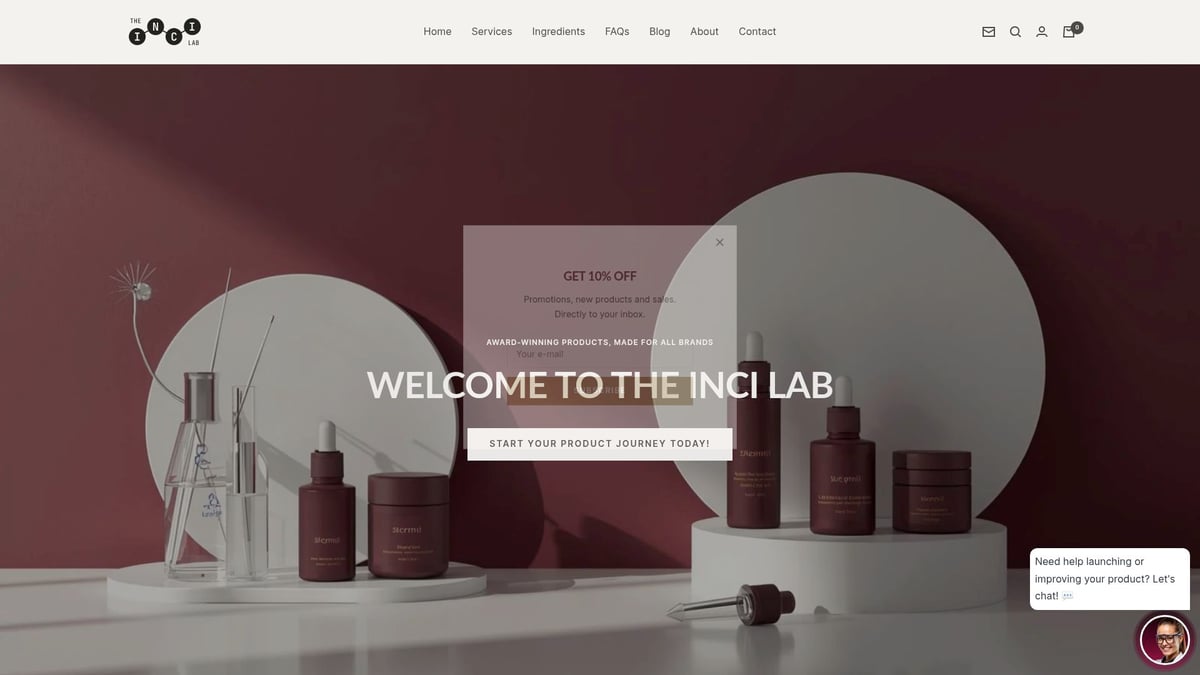
What sets INCI Lab apart in the cosmetic formulation space?
| Feature | INCI Lab Advantage |
|---|---|
| Full IP Ownership | You retain exclusive rights |
| Global Ingredient Access | Sourcing from leading suppliers |
| Award-Winning Team | Recognized scientific expertise |
| Sustainability Commitment | Eco-friendly focus |
| Personalized Support | From concept to launch |
Engagement is simple. You can contact their team directly, explore their consultancy options, or subscribe to the newsletter for updates and new client promotions. The process begins with a discovery call to understand your cosmetic formulation needs, followed by a step-by-step collaboration plan.
Ready to accelerate your next product launch? Working with INCI Lab means unlocking the full potential of your cosmetic formulation ideas with confidence, scientific precision, and a partner dedicated to your success.
As you’ve discovered throughout this guide, excelling in cosmetic formulation in 2025 means staying ahead of industry trends, prioritizing sustainable ingredients, and embracing technology for smarter, faster innovation. If you’re ready to put these insights into action—whether you’re launching a new brand or reinventing an existing line—now is the perfect time to take the first step. Let’s turn your ideas into high-performance, market-ready products with the support of experts who understand every phase of the process. Start Your Product Journey
